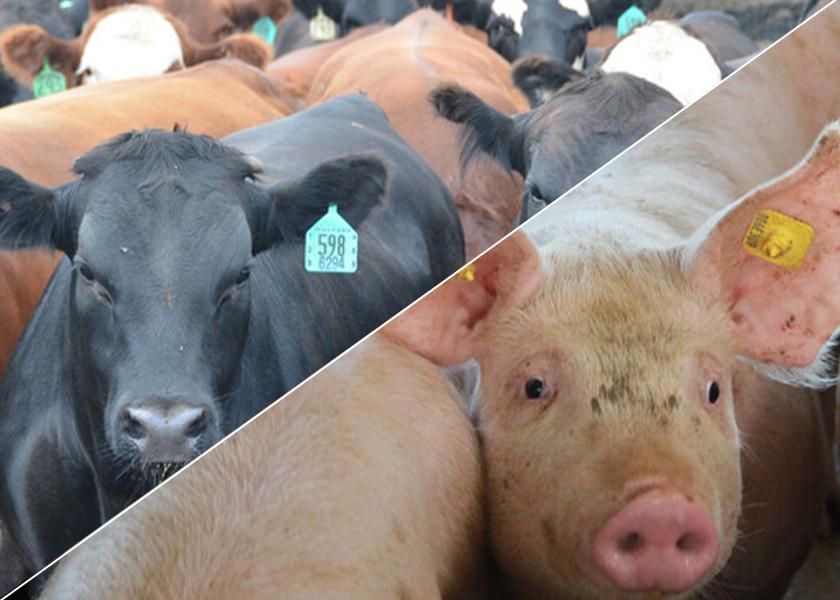Livestock Analysis | June 16, 2022

Price action: July hog futures surged $1.30 to $109.575, a two-week high. August hogs jumped $1.70 to $106.025.
Fundamental analysis: Resurgent wholesale prices powered fresh gains in hog futures, with pork cutout jumping $4.04 early today to $108.83. Although movement at 87 loads was mediocre, the virtual across-the-board gains in pork primal cuts, with the exception of picnics, apparently encouraged the bulls. Continued strength in the CME Lean Hog index also supported prices. The index is already at a 10-month high and is expected to rise another 18 cents Friday to $108.75. Considering the pork industry’s historical pattern of producing smaller supplies from late June into mid-July, some optimism about short-term price prospects seems justified. The ongoing heat-driven surge in the cash price of fed cattle may also have offered spillover support for the hog and pork complex.
With equity markets extending a deep slide amid growing recession concerns, hog futures’ advance was impressive. That may partially reflect ideas hot weather will hamper hog marketings this month, as well as the underlying belief that red meat markets hold up comparatively well during recessionary times. We may also be gaining company in doubting the U.S. hog herd will expand during the second half of 2022, as the USDA has been predicting.
Technical analysis: Bears still seem to hold the short-term technical advantage in August hog futures. Although today’s advance carried the market above the last week’s trading range and above its 10-day moving average near $105.29 for the first time since June 3, the contract still faces considerable resistance at its 20- and 40-day moving averages near $106.99 and $107.56, respectively. A breakout above those resistance points would have bulls targeting the June 2 high at $111.05, then the $115.00 level. A reversal from today’s close would open the door to a retest of support at today’s low of $103.50, then Monday’s low at $101.30 and later the psychological $100.00 level. A drop below that point would open the door to a test of the May 12 low at $98.65.
What to do: Be prepared to extend feed coverage on a pullback to the recent lows.
Hedgers: Carry all risk in the cash market for now.
Feed needs: You are hand-to-mouth on corn-for-feed and soybean meal needs.
Price action: August live cattle fell 50 cents to $136.30. August feeders tumbled $1.975 to $171.30.
Fundamental analysis: Nearby live cattle were supported by concern that extreme heat in the Plains will tighten supplies of market-ready animals. That was reflected in Wednesday’s trade, which apparently saw most steers and heifers trade around $145, thereby bringing the three-day average for the five-area direct markets up to $144.87. We don’t regard the sizeable feedlot death losses reported in Kansas and Nebraska as a major blow to the larger fed cattle supply picture, but the severity of the heat stress on all the animals in those lots will surely cause them to be “unthrifty,” meaning animals may lose some weight and be slow to recover. For this reason, we tend to think the discounts now built into nearby futures are overly large.
However, the flat showing posted by fed cattle futures today may not have reflected industry pessimism about the short-term outlook. That is, the selling probably came in response to another big drop in the equity indexes, which seemingly reflected a growing consensus that the U.S. economy will soon move into a recession, if it’s not already there. We still don’t think the livestock market are the best place to sell in response to such concerns, but the cattle and S&P 500 futures markets are still linked in the minds of many traders and investors (due to their former proximity on the old CME trading floor).
One certainly couldn’t be blamed for being in no hurry to buy feeder cattle futures in light of the mixed fed cattle showing, but today’s feeder selling likely reflected gains in corn and soymeal, which imply higher feed costs that could force feedyard managers to cut bids for replacement yearlings.
Technical analysis: Bulls still hold the short-term technical advantage in live cattle futures. Look for solid support at today’s low of $135.825, with strong backing from the contract’s 10- and 40-day moving averages at $135.28 and $134.86, respectively. A close below the latter level would have bears targeting the contract’s 20-day moving average near $133.85, then Monday’s low at $132.45 and later, $130.00. Initial resistance is likely at today’s high of $137.05, then yesterday’s top at $137.50. A push above those levels would have bulls looking to fill the April 25 chart gap between $138.75 and $140.275.
Bears again proved unable to force an August feeder futures close below the contract’s 40-day moving average near $170.96, which leaves the short-term technical advantage with the bulls. Look for additional support at the contract’s 20-day moving average at $170.17, then Monday’s low of $169.40. A close below that level would have bears targeting the June 1 low at $165.025, then the May 23 low at $162.80. Today’s high virtually coincided with the contract’s 10-day moving average of $173.15, thereby marking initial resistance. A bullish breakout would open the door to a test of last week’s high at $176.875, then the $180.00 area.
What to do: Be prepared to extend feed coverage on a pullback to the recent lows.
Hedgers: Carry all risk in the cash market for now.
Feed needs: You are hand-to-mouth on corn-for-feed and soybean meal needs.






